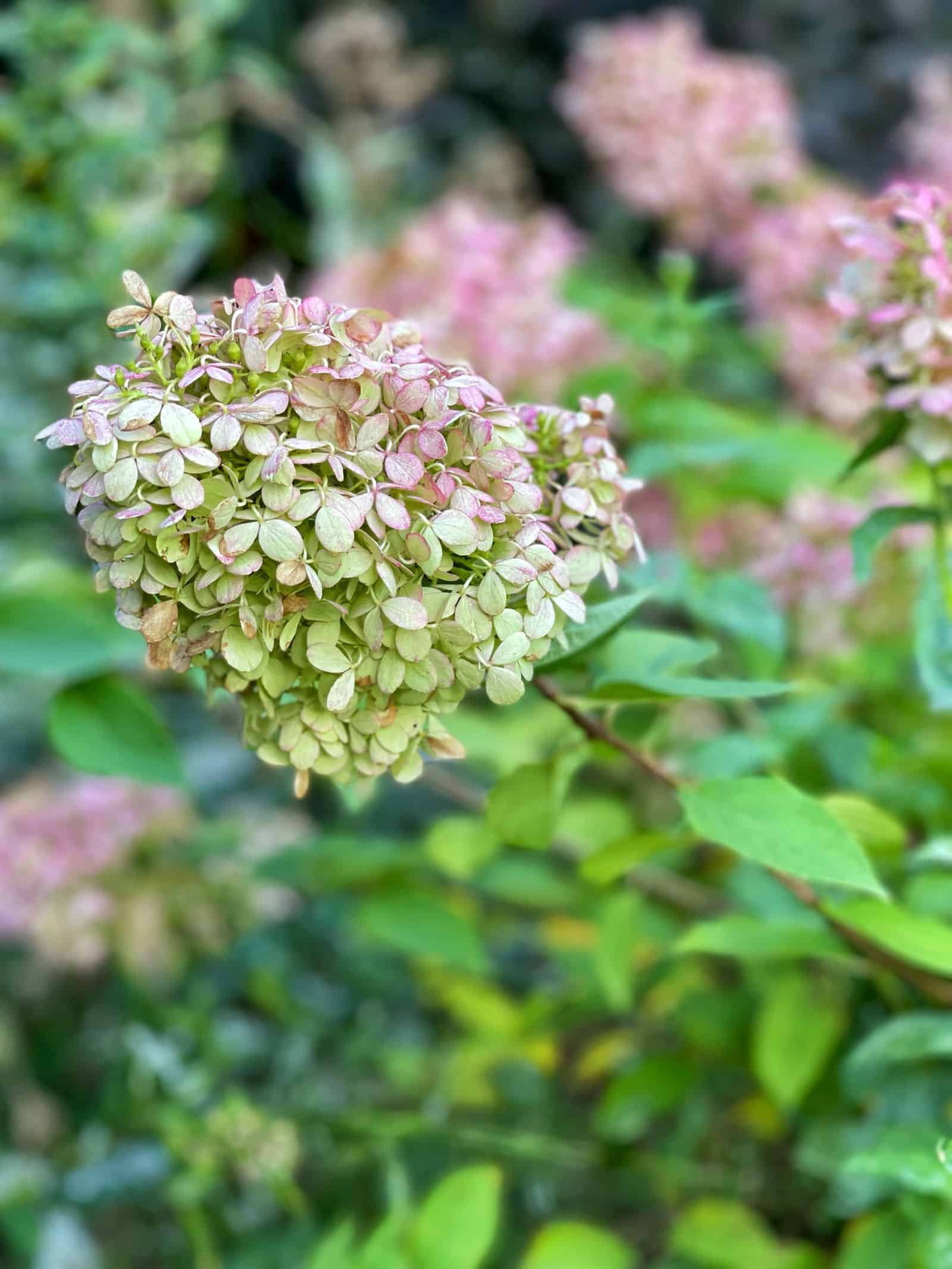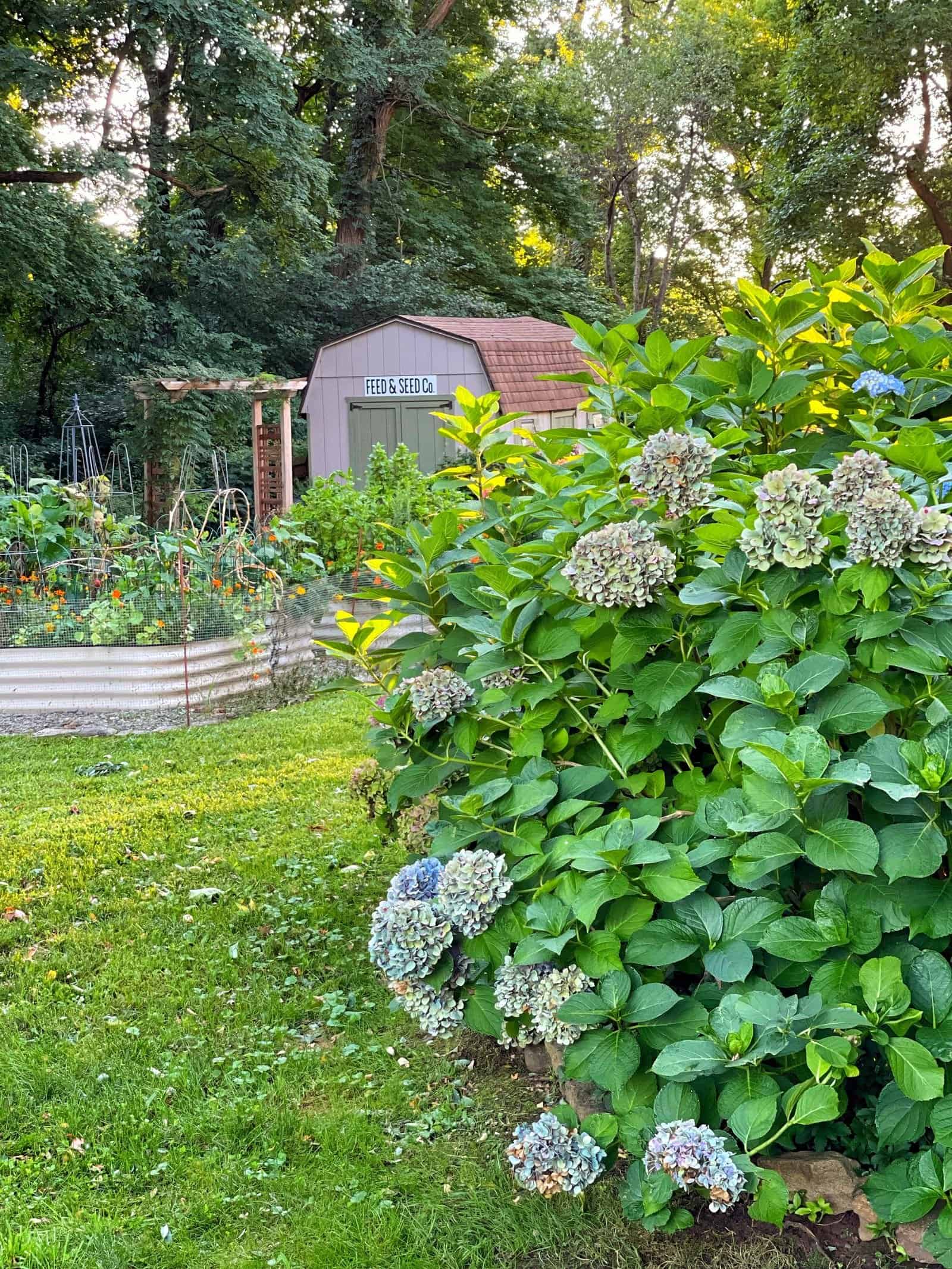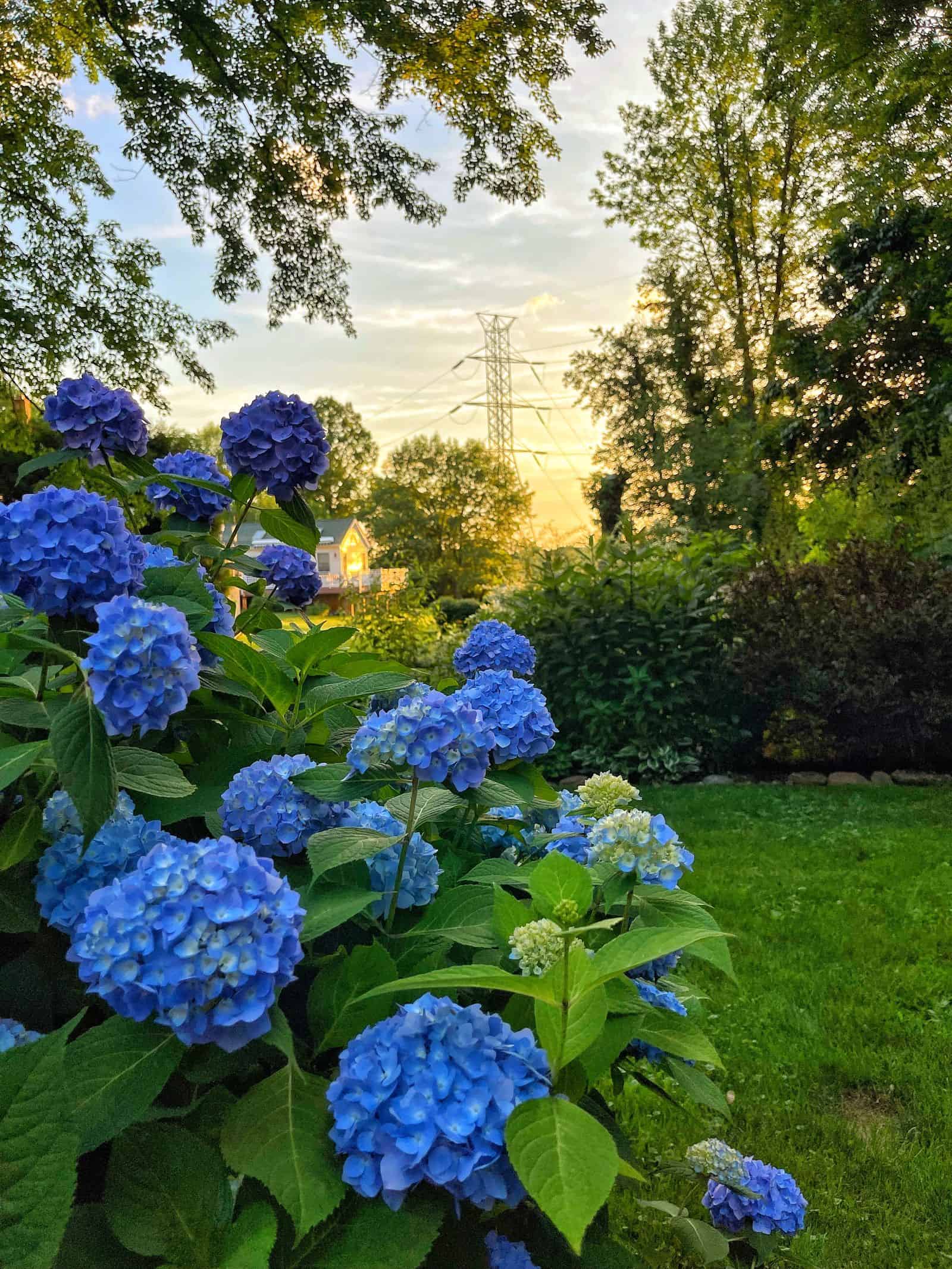Have you noticed your hydrangea not blooming this year? Or maybe it is blooming less than in years past? Here are 7 reasons why hydrangeas fail to bloom and how to fix it.
Hydrangeas are garden showstoppers, but their blooms aren’t always a guarantee. If your hydrangeas aren’t flowering, don’t despair! I’ve put together a guide with the most common culprits and easy fixes to get those blooms back on track. No matter your gardening experience, these tips will have your hydrangeas blooming in no time.
(Posts on stacyling.com may contain affiliate links. Click HERE for full disclosure.)

About Hydrangeas
Before we dive into the reasons behind those missing blooms, let’s take a quick refresher on hydrangeas. These popular ornamental plants thrive in USDA hardiness zones 4-9 and prefer moist, well-drained soil. While partial shade is ideal, some varieties soak up the sun. So, be sure to check the plant tag to understand your hydrangea’s specific needs.
In the garden, hydrangeas are versatile beauties, adding charm to hedges, foundation plantings, and mixed borders. But their allure doesn’t stop there. Hydrangea blooms make stunning cut flowers and can even be dried for long-lasting arrangements or crafts. Now that we’ve covered the basics, let’s get to the bottom of those missing blooms.
Is Your Hydrangea Not Blooming? Let’s Crack the Case!
Hydrangeas are usually the stars of the garden, but sometimes they decide to play hide-and-seek with their blooms. If your hydrangeas are keeping their flowers under wraps, it’s time to play detective.
From pruning faux pas to environmental factors, there are several possible explanations. But fear not! We’ll investigate the most likely suspects and provide actionable tips to get those blooms back in the spotlight.

Gift Hydrangeas: Beautiful Indoors, Not Always Outdoors
Receiving a hydrangea as a gift is always delightful, but those gorgeous blooms might not be meant for your garden. Florist or gift hydrangeas are raised in controlled environments and often struggle to thrive outdoors.
If your gift hydrangea isn’t flowering, don’t despair! It’s not a reflection of your gardening skills. Instead, consider it a chance to explore other hydrangea varieties better suited for your garden’s conditions.

Sunlight: The Hydrangea’s Blooming Elixir
Hydrangeas have a bit of a Goldilocks complex when it comes to sunlight. They need just the right amount to produce those gorgeous blooms. Most varieties thrive with morning sun and afternoon shade, soaking up at least 4 hours of dappled sunlight each day. However, some hydrangeas prefer basking in full sun.
So, where did you plant your hydrangea? If it’s languishing in too much shade, that could be the reason behind the missing flowers. Check the light requirements for your specific variety, and if needed, relocate it to a sunnier spot. Your hydrangea will thank you with a vibrant display of blooms!

Pruning Pitfalls: Timing is Everything for Hydrangea Blooms
Did you know that pruning your hydrangea at the wrong time can sabotage its blooming potential? It’s true! Different hydrangea varieties have distinct pruning needs based on whether they bloom on old wood (last year’s growth) or new wood (this year’s growth).
Here’s a quick breakdown:
- Old wood bloomers (Hydrangea macrophylla): Prune these right after flowering. Cutting them back in fall or early spring removes the forming buds, preventing blooms.
- New wood bloomers (Hydrangea arborescens, Hydrangea paniculata): Prune in late winter or early spring. I cut back my Limelight Hydrangea (paniculata) hard each spring, and it rewards me with stunning blooms every fall.
- Both old and new wood bloomers (Everblooming/Endless Summer Hydrangeas): These are more forgiving, but pruning right after flowering is still ideal.
Not sure which type you have? Your local cooperative extension or master gardener program can help with identification. If all else fails, skip pruning for a season and see how your hydrangea responds the following year.
If a landscaper or someone else cares for your hydrangea, they may be pruning them at the wrong time.

Soil Check: Is Nitrogen Stealing the Show from Your Hydrangea Blooms?
Soil health plays a crucial role in hydrangea flowering. Have you ever tested your soil? High nitrogen levels, often caused by over-fertilization, can encourage lush foliage at the expense of blooms. Nitrogen fuels leafy growth, but hydrangeas need a balanced diet to flower.
If your hydrangea isn’t blooming, consider how much and how often you’ve been fertilizing. A simple soil test can reveal if excess nitrogen is the culprit. Armed with that knowledge, you can adjust your fertilizing routine and get those blooms back on track.

Overly Fertilizing Hydrangeas
Are you fertilizing your hydrangeas? I don’t fertilize any of my perennials, shrubs, or trees. But I know people some do.
Overly fertilizing promotes big healthy leaves instead of flowers. Stop fertilizing them and see if that improves flowering the following season. As an alternative to fertilizing, focus more on improving the quality of your soil.
Test the soil and based on those results, add compost, leaf mold, and other soil amendments that are more organic options rather than blindly applying chemicals.
Recently Planted Hydrangeas
When were the hydrangeas planted? Hydrangeas may not flower within the first few years of planting because they spend their energy developing good, healthy root systems.
I planted a Climbing Hydrangea that took several years to bloom. So be patient and give them some time to grow strong healthy roots before expecting blooms.
Hydrangea Not Blooming: The Climate Impact
While the hydrangea root system might be hardy to your climate, the buds might have been killed by an extremely cold winter or an early spring freeze. In these cases, you will want to wrap your hydrangea with burlap in late fall to help protect it from harsh winter conditions.

How Do You Fix Hydrangeas That Don’t Bloom?
If you’re struggling with hydrangeas that aren’t blooming, there are a few things you can try to get them back on track. Here are some tips to try.
- Prune properly: If you’re not seeing blooms, it could be because you’re pruning at the wrong time.
- Test your soil and see if there is too much nitrogen or not enough nutrition to feed the plant.
- Ensure adequate water: Hydrangeas like consistently moist soil, so make sure you’re watering them regularly, especially during dry spells. But be careful not to overwater, as this can also cause problems. If you’re not sure whether your hydrangeas are getting enough water, check the soil with your finger – it should be evenly moist but not waterlogged.
- Provide the right amount of sunlight: Hydrangeas do best with morning sun and afternoon shade. If they’re getting too much sun or too much shade, it can affect their ability to bloom. Try moving them to a spot with better light conditions.
- Avoid overfertilizing. In fact, I recommend stop fertilzing and focus on soil quality. Add compost, aged manure, and leaf mold to help improve it.
- If they were recently planted, give them more time to develop a good root system. Remember that hydrangea can be slow to establish, so don’t give up on them too quickly.

Frequently Asked Questions About Hydrangea Not Blooming
Why are my hydrangea buds turning brown?
Buds may turn brown due to frost damage, insufficient water, or fungal infections. Protect plants from late frosts, ensure consistent watering, and treat with fungicide if needed.
Can hydrangeas bloom in the shade?
While some hydrangeas tolerate partial shade, most need at least 4-6 hours of sunlight to bloom well. Ensure your hydrangea receives enough light for optimal blooming.
How does pruning affect hydrangea blooming?
Improper pruning can remove flower buds. Know your hydrangea type—prune old wood varieties after they bloom and new wood varieties in early spring.
Does soil pH affect hydrangea blooms?
Soil pH affects flower color, not blooming. However, well-balanced soil with proper nutrients is crucial for healthy blooms. Test soil and amend as needed.
Why isn’t my newly planted hydrangea blooming?
Newly planted hydrangeas might take a couple of years to establish before blooming. Ensure proper planting depth, watering, and patience as the plant acclimates.

Final Thoughts on Hydrangea Care and Lack of Blooms
Understanding why your hydrangea isn’t blooming can be a bit challenging, but by addressing the common issues such as pruning practices, sunlight exposure, soil conditions, and fertilization, you can greatly improve your plant’s chances of flowering.
Remember, patience is key as hydrangeas might take a season or two to fully recover and bloom after adjustments. Keep experimenting with care techniques and observe what works best for your garden. Happy gardening!
Did your hydrangeas fail to bloom this year? What are your tips for getting more flowers and encouraging bloom? I would love to know more in the comments below.
For more information regarding why Hydrangeas refuse to bloom, see Penn State Extension and University of Massachusetts Amherst.
If you have any questions, comments or suggestions, please let me know in the comments below. I’d love to hear! And feel free to share this post with anyone you think would find it helpful too.
To drill down on more beginner gardening techniques and tips, please read these posts:
- Flower Gardening 101
- Growing a Cut Flower Garden for Beginners
- Container Garden Ideas for Beginners
- How to Start a Vegetable Garden
- Herb Gardening for Beginners
Thank you for visiting the blog today!
Enjoy your day! xo


More Hydrangea Posts You May Enjoy
- The Complete Guide to Hydrangea Care and Their Flowers
- The Basics of Hydrangea Care
- How to Dry a Hydrangea the Easy Way
- The ULTIMATE Guide to Keeping Fresh Cut Hydrangeas from Drooping
- How to Divide Hydrangeas
- How to Propagate Hydrangeas in 7 Easy Steps
- Are Hydrangeas Deer Resistant?











I’m so glad I looked into the reason why my hydrangea not blooming. I have a few Macrophyllas that are in pretty dense shade.
Since I’ve been too lazy to dig them out and transplant them, they leaf out, look healthy, but don’t bloom. If I want to get this hydrangea to bloom, I need to move it stat.
The bigger concern for me is the lack of blooms on my Endless Summer Hydrangeas. They bloomed profusely from May through November for several years.
But a few years ago, we started paying a landscaper to do fall clean-ups. And he cut them back to the ground without my consent. And they have not been the same since.
It’s been about two years since they’ve been cut back and the light conditions have not changed, and yet, my endless summer hydrangeas aren’t blooming.
So I suspect they are they are receiving too much fertilizer from the lawn and here’s why:
I have been over-seeding my lawn and adding fertilizer to help those seeds grow. With all the rain we have had in the last two growing seasons and slope of the ground, that fertilizer may be seeping in and impacting my Hydrangeas.
To see if I am correct, I will test the soil to see if there is a high level of nitrogen present and be sure to avoid that area with fertilizer in the future.
For me, it’s not worth risking the blooms to have a green lawn right next to it.








